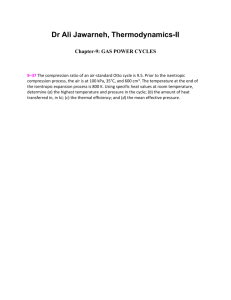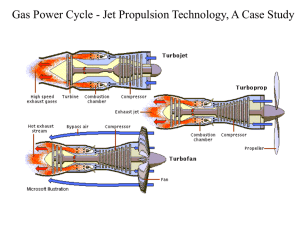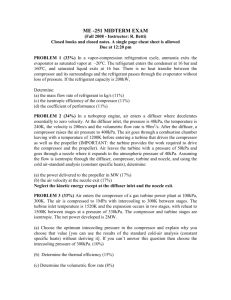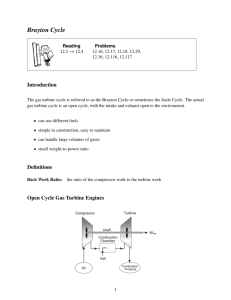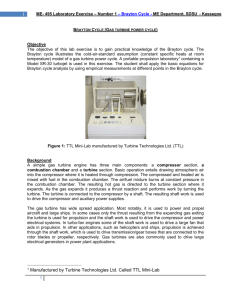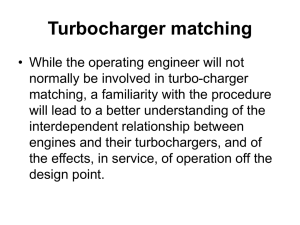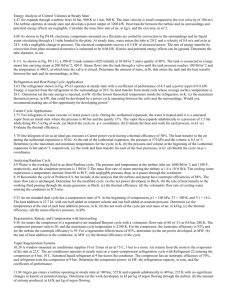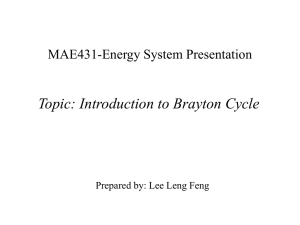ME 495 Lab 4 Brayton Cycle (1)
advertisement
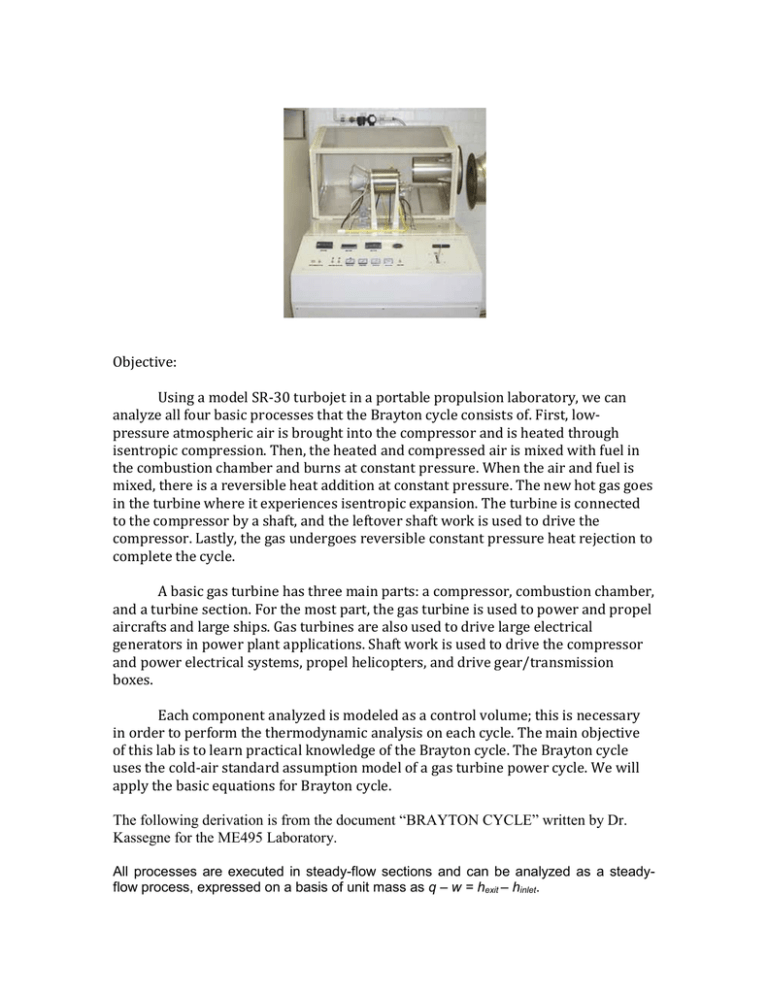
Objective: Using a model SR-30 turbojet in a portable propulsion laboratory, we can analyze all four basic processes that the Brayton cycle consists of. First, lowpressure atmospheric air is brought into the compressor and is heated through isentropic compression. Then, the heated and compressed air is mixed with fuel in the combustion chamber and burns at constant pressure. When the air and fuel is mixed, there is a reversible heat addition at constant pressure. The new hot gas goes in the turbine where it experiences isentropic expansion. The turbine is connected to the compressor by a shaft, and the leftover shaft work is used to drive the compressor. Lastly, the gas undergoes reversible constant pressure heat rejection to complete the cycle. A basic gas turbine has three main parts: a compressor, combustion chamber, and a turbine section. For the most part, the gas turbine is used to power and propel aircrafts and large ships. Gas turbines are also used to drive large electrical generators in power plant applications. Shaft work is used to drive the compressor and power electrical systems, propel helicopters, and drive gear/transmission boxes. Each component analyzed is modeled as a control volume; this is necessary in order to perform the thermodynamic analysis on each cycle. The main objective of this lab is to learn practical knowledge of the Brayton cycle. The Brayton cycle uses the cold-air standard assumption model of a gas turbine power cycle. We will apply the basic equations for Brayton cycle. The following derivation is from the document “BRAYTON CYCLE” written by Dr. Kassegne for the ME495 Laboratory. All processes are executed in steady-flow sections and can be analyzed as a steadyflow process, expressed on a basis of unit mass as q – w = hexit – hinlet. The thermal efficiency of the ideal Brayton cycle is: thBrayton wnet 1 qout qin T T1 4 C p (T4 T1 ) T 1 1 1 1 C p (T3 T2 ) T T2 3 T2 1 Processes 1 2 and 3 4 are isentropic, and P2 = P3 and P1 = P4 therefore: T2 P2 T1 P1 k 1 / k P 3 P4 k 1 / k T3 T4 Using these relationships the thermal efficiency simplifies to: th,Brayton = 1 – 1 . rP(k-1)/k Where rP is the pressure ratio = P2/P1 and k is specific heat ratio, which is 1.4 for air at room temperature. The back work ratio is defined as the ratio of compressor work to turbine work and is given as: rbw = wCOMP,in/wTURB,out Figure 2: SR-30 Engine. Q in Combustion Chamber 2 Compressor 3 Wout Turbine Win 1 Atmospheric air 1 2 3 4 2 3 4 3 : Isentropic c om pression : Reversible c onstant pressure heat addition : Isentropic expansion : reversible c onstant p ressure heat rejec tion 4 Hot exhaust Figure 3: Basic Brayton cycle. Figure 4: T – s and P v diagrams for the ideal Brayton cycle. a) Compressor Section Ideally there is no heat transfer from the control volume to the surroundings. Under steady-state conditions (and neglecting potential and kinetic energy effects) the First Law for the control volume is: H W = H i n i n o u t 2 Control volum e Compressor Win 1 Figure 5: Compressor, control volume model. This can be rewritten in a more specific form of the First Law considering there is one flow into and one flow out of the control volume: m h m w = m h i n C o u t The terms are rearranged and the enthalpy is rewritten using the equation of state: dh = cpdT, which assumes the working fluid is an ideal gas and constant specific heat. w = h h = c ( T T ) C o u t i n p , C C , o u t C , i n For accurate analysis of the compressor the specific heat of the fluid should be evaluated at the linear average between the inlet temperature and the outlet temperature: (Tin -Tout)/2. The irreversibility present in the real process can be modeled by calculating the efficiency () of the compressor: C = wc,s = wc,a hout,s – hin = Tout,s – Tin hout,as – hin Tout,a – Tin Where the subscript “s” refers to the ideal or isentropic process and the subscript “a” refers to the real or actual process. For a perfect gas the above equation is reduced to: C = Tout,s – Tin Tout,a – Tin b) Combustion Section In the ideal combustion section no work is transferred to the surroundings from the control volume. Under steady-state conditions, and neglecting kinetic and potential energy effects, the first law application is: Figure 6: Combustion chamber, constant pressure model. Considering that we have one flow in and one flow out of the control volume, we can use a more specific form of the first law. Or, rearrange by grouping the terms associated with each stream: qB = hout – hin. Assuming ideal gasses and constant specific heats, enthalpy differences are readily expressed as the temperature differences as: qB = Cp,B (TB,out – TB,in) Again, to be more accurate, the specific heat of each fluid should be evaluated at the linear average between its inlet and outlet temperature. C) Turbine Section No heat is transferred to the surroundings in the ideal conditions for a control volume turbine section. Under steady-state conditions, and neglecting kinetic energy and potential energy effects, the first law for this control volume is then written: Figure 7: Turbine, control volume model Rearranging the terms associated with each stream gives wT = hout – hin. Assuming ideal gasses and constant specific heats, enthalpy differences are readily expressed as the temperature differences as: wT = Cp,T (TT,out – TT,in) To be more accurate, the specific heat of each fluid should be evaluated at the linear average between its inlet and outlet temperature. The irreversibility present in the real process can be modeled by calculating the efficiency () of the compressor: T = wc,a = hout,a – hin = Tout,a – Tin wc,s hout,s – hin Tout,s – Tin Where the subscript “s” refers to the ideal or isentropic process and the subscript “a” refers to the real or actual process. For a perfect gas the above equation is reduced to: T = Tout,a – Tin Tout,s – Tin EXPERIMENT PROCEDURES WARNING Before starting the experiment, make sure you read the following. 1. Make sure that neither you nor any of your belongings are placed in front of the intake or the exhaust sections of the SR-30 engine while it is operating. 2. Ear protection must be worn while the SR-30 engine is operating. 3. The SR-30 engine rotates at very fast speeds. Therefore, stay far away from the test bench to avoid injury if the engine malfunctions. 4. Make sure the engine low-oil-pressure light extinguishes immediately after engine start-up. If the light stays illuminated or lights at any time during engine operation turn off the fuel flow to the SR-30 engine immediately. 5. If at any time you suspect the SR-30 engine is not operating properly immediately turn off the fuel flow and shut down the engine. Term Q in/out W in/out h T P C h k Value Heat in/out [m^2] Volume in vessel 2 [m^2] Specific enthalpy [] Temperature [kelvin] Pressure [kPa] [] Thermal efficiency [unitless] Specific heat ratio [unitless]

